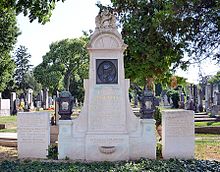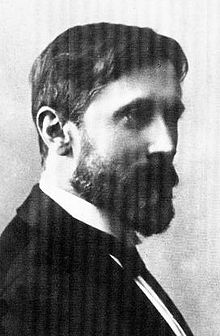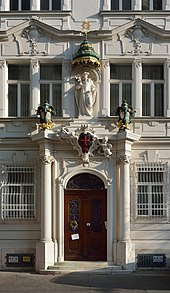Karl Mayreder
Karl Mayreder (born June 13, 1856 in Mauer , today Vienna ; † September 9, 1935 in Vienna) was an Austrian architect . He was the husband of the women's rights activist Rosa Mayreder .
Live and act
Karl Mayreder was born as the eldest of three sons of the hotelier Leopold Mayreder, who successfully ran the "Matschakerhof" in the inner city (1st district), Spiegelgasse 5 / Seilergasse 6, which was very well known as a restaurant and hotel , and his wife Henriette. All three sons turned to architecture and construction; like Karl also Julius (1860–1911) and Rudolf Mayreder (1864–1937), who founded the construction company Mayreder-Kraus & Co., which still exists today.
Karl studied from 1872 to 1877 at the Technical University of Vienna , where he was a student of Heinrich von Ferstel and later Karl König's assistant . While still a student he learned the science and to an improvement in the status of women interested Rosa Obermayer at a regular Stammtisch know who was the only way for them to get their personality to develop according to their ideals. The two married in 1881. From 1880 to 1884 he worked in Ferstel's studio.
From January 24, 1885 he was a member of the Vienna Künstlerhaus , and from 1888 of the Austrian Association of Engineers and Architects . In 1893 he and his two brothers won the competition to regulate the Stubenviertel, part of the 1st district, in Vienna and, also with his brothers, received a 2nd prize for a project on the city regulation plan of Vienna.
From 1894 to 1902 Karl Mayreder was the head of the city regulatory office of the Vienna City Building Office . A number of urban planning projects at the time , especially road breakthroughs, went back to him. This role also led to his appointment as a juror for competitions on urban regulation projects in several European cities.
In 1898 he was appointed associate professor for the propaedeutics of architecture , in 1900 he was appointed full professor for the architecture of antiquity . He was also the driving force behind the introduction of a chair for urban planning at the Technical University. In the academic year 1922/23 he held the office of rector at the university, but had to resign due to illness in January 1923 and retire in 1925. In 1929 he was made an honorary doctorate from the Graz University of Technology .
In addition to his public functions, Mayreder also worked as a private architect and built several palaces and other buildings, although his authorship is not secured for several of them.
Councilor o. Univ.-Prof. i. R. Dr. Karl Mayreder was buried in the Vienna Central Cemetery next to his parents Leopold and Henriette Mayreder, his brother Julius Mayreder and his sisters in the family grave, Group 43 E, Row 1, No. 33. In 1938 his widow, Rosa Mayreder, was also buried there.
The 500 Schilling banknote from 1997, one of the last two banknotes in the Schilling currency, shows a portrait of Rosa Mayreder on the front and Rosa and Karl Mayreder on the reverse (see illustration above) and a group picture of the participants in the Bundestag Austrian Women's Association in Vienna 1911.
Works (selection)

- Palais Oberleitner, Mährisch Schönberg
- Palais Isbary , Vienna 4
- Kreuzherrenhof, Vienna 4 (together with Julius Mayreder)
- Zacherl insect powder factory , Vienna 19
For further works see Julius Mayreder
literature
- R. Schachel: Mayreder Karl. In: Austrian Biographical Lexicon 1815–1950 (ÖBL). Volume 6, Verlag der Österreichischen Akademie der Wissenschaften, Vienna 1975, ISBN 3-7001-0128-7 , p. 9.
Individual evidence
Web links
- Karl Mayreder. In: Architects Lexicon Vienna 1770–1945. Published by the Architekturzentrum Wien . Vienna 2007.
- Literature by and about Karl Mayreder in the catalog of the German National Library
| personal data | |
|---|---|
| SURNAME | Mayreder, Karl |
| BRIEF DESCRIPTION | Austrian architect |
| DATE OF BIRTH | June 13, 1856 |
| PLACE OF BIRTH | Wall (vienna) |
| DATE OF DEATH | September 9, 1935 |
| Place of death | Vienna |




